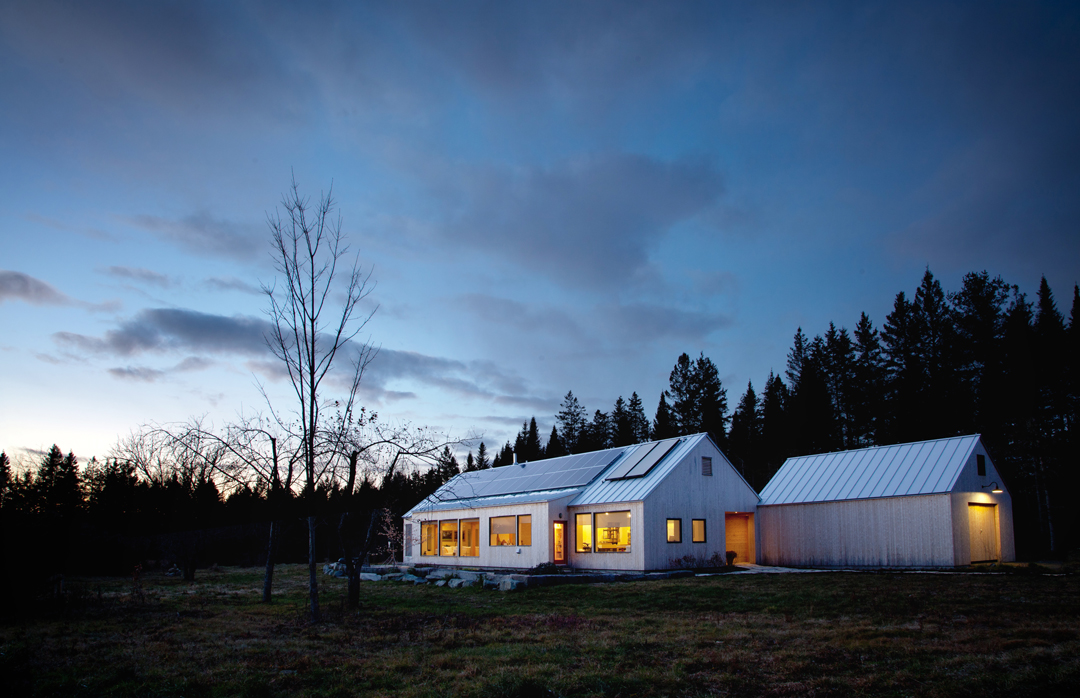Lancaster Low Energy: Built to Passive House Standard

By The Numbers
Tom and Nancy’s Passive House NumbersSpecific Space Heat Demand
4.45 kbtu/sq ft/year
Specific Space Heat Demand is the annual amount of heat required to keep the building at 68 F
Air Tightness
.649 ACH50
Specific Primary Energy Demand
28.5 kBTU/(ft2yr)
DHW, Heating, Cooling, Auxilary and Household Electricity
Peak Demand
4.83 BTU/ft2 (7,825 BTU/HR)
Amount of heat required in btus to keep the house at 68F when it is -20 F outside.
Treated Floor Area
1620 sq ft.
Treated floor area is the measurement of net habitable floor area within the thermal envelope.
Envelope Numbers
Foundation:
12” Polyisocyanurate – R-55
Walls:
12” Dense Packed Cellulose cavity insulation plus 2” polyisocyanurate continuous rigid foam board. – R-49
Roof:
40” loose fill cellulose. – R-140
Windows:
Low-Iron, Triple Glazed, Insulated Fiberglass Frame Windows. U-.19. SHGC .61 VT 50
Mechanicals
Heating
EPA certified wood stove with dedicated combustion oxygen for primary heat.
2250 watts of electric resistance heating for back-up.
Hot Water
80 sq ft. of solar collector. 120 gallon stone lined tank with electric resistance back up
Ventilation
Comfoair 200 by Zehnder
Renewable Energy Generation
7.1KW photovoltaic array
Energy Balance to Date
Total Production: 5282 kwh
May 10, 2011-December 23, 2011
Total Use: 2045 kwh
May 10, 2011-December 23, 2011
Domestic Hot Water (DWH) 172 kwh
Total Banked:3237 kwh
Tom and Nancy decided to downsize into a smaller, sun-filled, low-maintenance, low-energy home after thirty-five years in a beautiful, cold, charming, wet-basemented, drafty old farmhouse. They didn’t want to go far. In fact, the house they built is within sight of their old home but for a few trees.
Several primary goals were established for the new structure: a warm home during the cold winter with low energy bills, little maintenance and universal-access living to ease living as they aged.
The home, inside and out, was designed all on one floor with doors at grade for easy entry and exit and bathrooms with spacious toilet and shower volumes and plenty of framed backing for future ADA handles if needed.
Making the home half the size of their old farmhouse and eliminating the basement cut out a good deal of maintenance and made for half the cleaning. Making the bulk of the outdoor living space patio with raised beds for the garden eliminated mowing and brought fresh produce right to the kitchen door. Quite literally.
As for the warm house in a cold winter and low utility bills, Tom and Nancy opted to follow the Passive House standard (see side bar) and threw in some solar PV for good measure. They are on schedule to be net energy producers on an annual basis.
Finally, Nancy wanted a simple modern aesthetic. This was achieved in a variety of ways. Materials were local, often salvage, always simple. White cedar cladding. Soapstone counters. White Pine Timber. Beech floors. Plaster walls. Galvanized steel roof. Windows with plaster jamb returns. For the big glass, maple sills were made from a blow down at a local sugar orchard. Modern Danish wood stove. Flooring installed to the plaster walls with no baseboard trim. Salvage hardwood solid core doors with the wooden jambs doing double duty as both jamb and trim. The interior design makes use of a modern airy palette for walls and ceilings, and a warm rustic hardwood plank floor to counterpoint and collect everything into a whole.
The result? You can be the judge of our success in simple, modern, sunlit beauty by viewing the house’s photo gallery. Passive House and energy performance numbers can be seen in the side bar.
Introduction to the Passive House Standard
Passive House is a simple but rigorous building standard popularized in Germany and introduced to North America over the course of the last couple of years. The chief benefits of building to Passive House standards are superior indoor air quality, excellent thermal comfort and very durable building assemblies. The by product of these benefits is a very warm house with very low energy bills. In order to achieve Passive House certification, a building has to meet three basic, but demanding performance standards:
- Specific Space Heat Demand of less than 4.75kbtu/sq ft/year
- Air Tightness of .649 ACH50 as measured by a blower door.
- 38.1 kbtu/sq ft annual primary energy* use for the total building including heat, domestic hot water and all plug loads.
*Primary Energy, simply put, is a ratio of the units of energy required to be produced at the power plant in order to provide a delivery unit of energy to the house of a customer. In the Northeastern U.S. for every kilowatt of electricity used at a home, on average 3.2 kilowatts of energy must be produced at the power plant.
